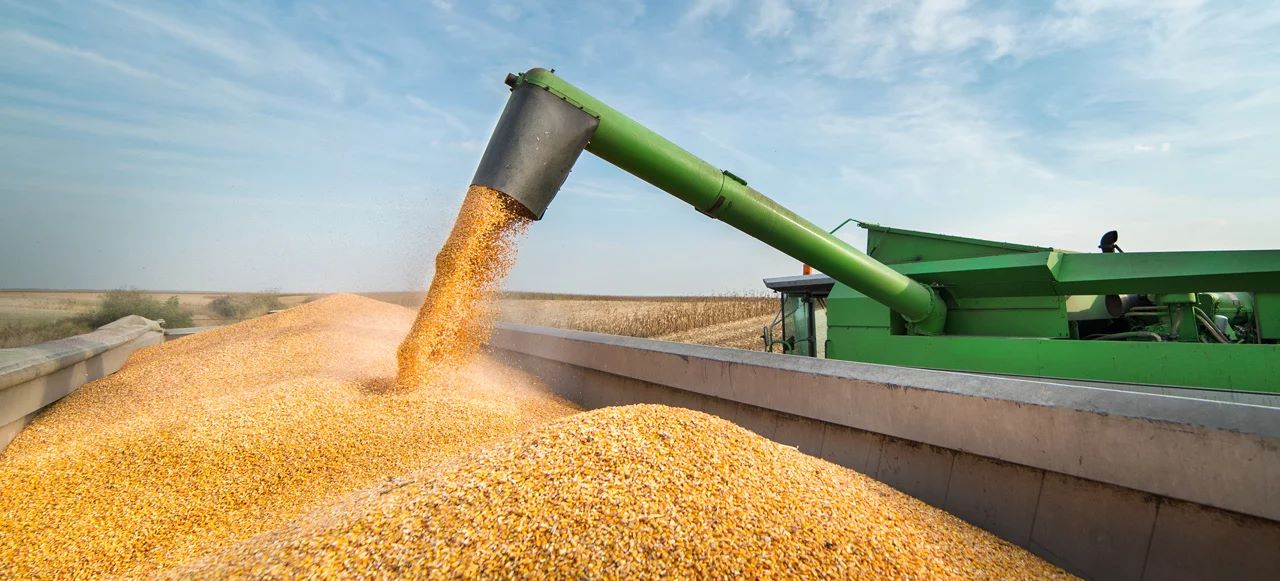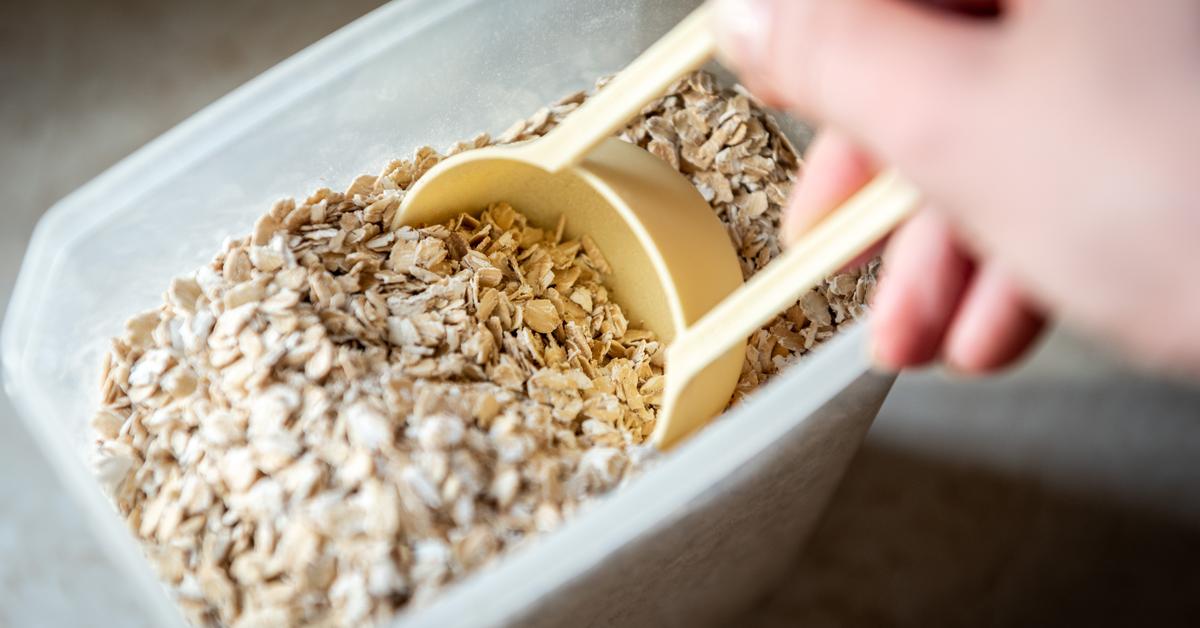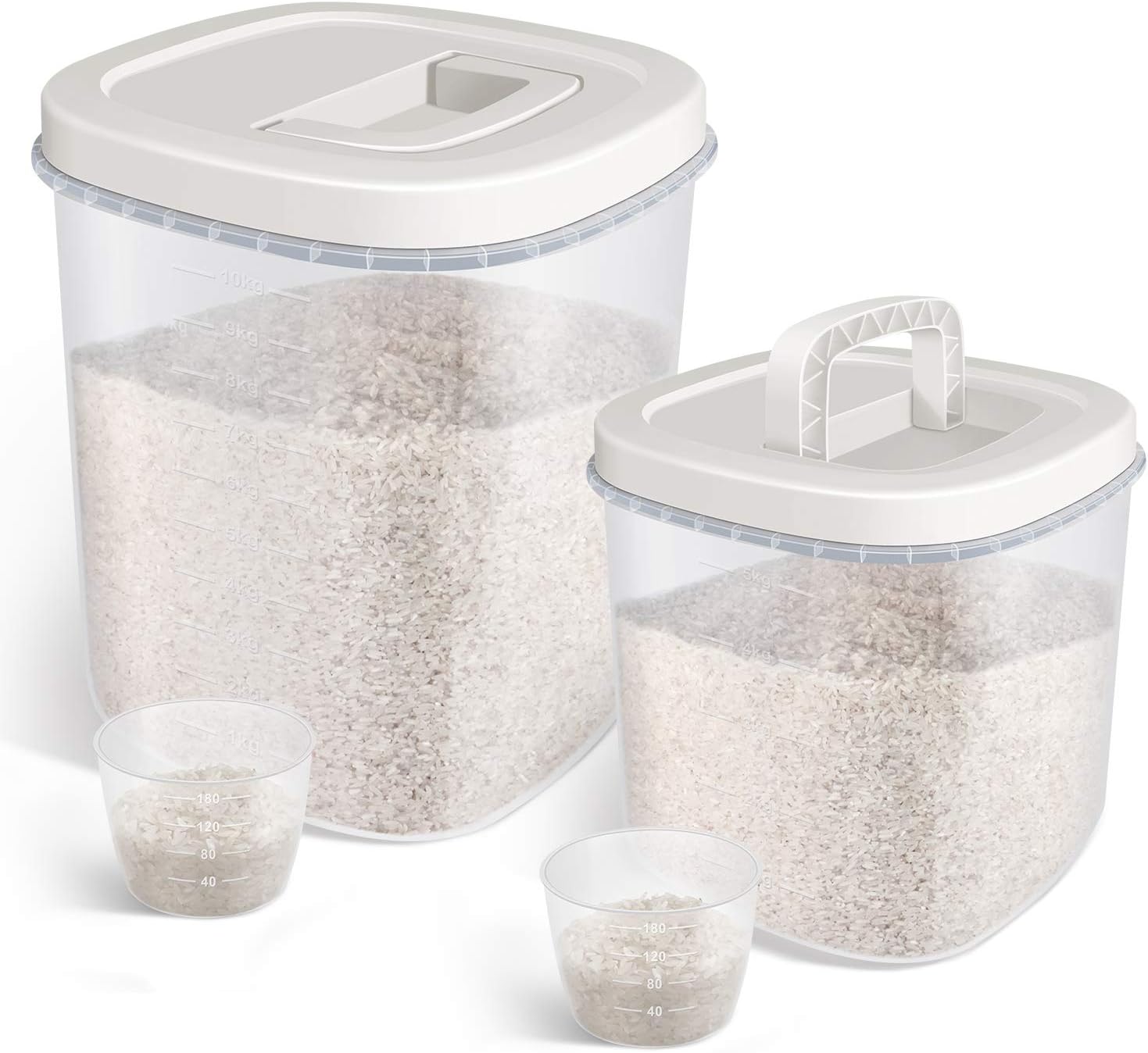

Articles
How To Store Grain Long Term
Modified: December 7, 2023
Learn the best methods for storing grain long term in this informative article. Discover essential tips and tricks to ensure your grain stays fresh and preserved for extended periods of time.
(Many of the links in this article redirect to a specific reviewed product. Your purchase of these products through affiliate links helps to generate commission for Storables.com, at no extra cost. Learn more)
Introduction
Storing grain long term is a critical practice for individuals and organizations involved in agriculture, food security, and emergency preparedness. Whether you’re a farmer looking to preserve your harvest or a prepper preparing for uncertain times, proper grain storage can help ensure a stable food supply and minimize waste. This article aims to provide comprehensive guidance on how to store grain long term effectively.
Grain, such as wheat, rice, corn, and oats, is a staple food for billions of people worldwide. It is also a valuable commodity for farmers and businesses involved in the agricultural industry. However, grains are susceptible to damage from factors such as moisture, pests, and temperature fluctuations, which can lead to spoilage, contamination, and financial losses.
By investing time and effort into proper grain storage, you can protect your grain from these risks and extend its lifespan. This not only preserves the nutritional quality of the grain but also ensures a consistent and reliable food supply throughout the year.
Before delving into the specifics of long-term grain storage, it’s important to emphasize the importance of quality grain. Starting with clean, dry, and undamaged grain will greatly increase your chances of successful long-term storage. Therefore, it is crucial to properly handle and prepare your grain before even thinking about long-term storage.
In the following sections, we will explore the key factors to consider before storing grain, the various storage containers available, how to prepare grain for long-term storage, tips for proper storage techniques, potential risks and how to mitigate them, as well as the importance of monitoring and inspecting stored grain. Let’s delve into the details and discover how to effectively store grain long term.
Key Takeaways:
- Ensure grain quality, proper storage containers, and regular monitoring to safeguard long-term grain supply for food security, price stability, and emergency preparedness.
- Implement rotation, pest control, and moisture management to maintain grain freshness, quality, and viability, ensuring a reliable source of sustenance.
Read more: How To Store Spaghetti Long Term
Reasons for Storing Grain Long Term
There are several reasons why individuals and organizations choose to store grain long term. Let’s explore some of the main motivations behind this practice:
- Food Security: One of the primary reasons for storing grain long term is to ensure food security. By maintaining a stockpile of grain, you can safeguard against potential food shortages caused by natural disasters, crop failures, or other unforeseen events. This is particularly crucial for areas with unreliable food supply chains or regions prone to emergency situations.
- Price Stability: Grain prices can fluctuate significantly due to various factors such as supply and demand, weather conditions, and market speculation. By storing grain long term, you can hedge against price hikes and potential scarcity in the market. This is especially beneficial for farmers who can wait for favorable market conditions before selling their grain.
- Self-Sufficiency: Storing grain long term enables individuals and families to become more self-sufficient. By having a stockpile of grain, you can reduce dependency on external food sources and have a reliable source of nutrition during challenging times. This is particularly appealing for homesteaders, preppers, and individuals living in remote areas.
- Emergency Preparedness: Along with food security, long-term grain storage plays a vital role in emergency preparedness plans. Whether it’s a natural disaster, economic crisis, or civil unrest, having a supply of stored grain can provide peace of mind and ensure you have access to essential sustenance when traditional food sources may be disrupted.
- Financial Benefits: Proper grain storage can contribute to financial benefits, especially for farmers and businesses. By storing grain long term, they can take advantage of possible price increases over time, store grain during periods of high production when prices are low, and sell at a later date for a better return on investment.
These are just a few of the many reasons why storing grain long term is an essential practice. It offers numerous advantages, such as food security, price stability, self-sufficiency, emergency preparedness, and financial benefits. By understanding these motivations, you can make informed decisions and take the necessary steps to store grain effectively for the long term.
Factors to Consider Before Storing Grain
Before you embark on the process of long-term grain storage, it’s important to consider several key factors that can significantly impact the success of your storage efforts. Let’s explore these factors:
- Grain Quality: The quality of the grain you intend to store is crucial. Ensure that the grain is clean, dry, and free from any contaminants or pests. Low-quality grain can deteriorate quickly during storage, leading to spoilage and financial losses.
- Storage Space: Assessing the available storage space is critical. Consider the volume of grain you’re planning to store and ensure that you have sufficient room to accommodate it. The storage space should also be well-ventilated, free from direct sunlight, and protected from pests and moisture.
- Climate and Environmental Conditions: The climate and environmental conditions in your area play a significant role in grain storage. High humidity, extreme temperatures, and excessive moisture can promote spoilage, mold growth, and insect infestations. Take these factors into account and implement appropriate measures to mitigate their impact.
- Storage Container Options: Choosing the right storage container is vital. There are various options available, including bins, silos, sacks, and barrels. Each has its advantages and considerations, such as cost, ease of use, capacity, and durability. Assess your specific needs and select a container that suits your requirements.
- Pest Control: Implementing effective pest control measures is essential to prevent insect infestations that can damage stored grain. This includes regular cleaning of storage containers, using insecticides and repellents, and ensuring proper sealing to keep pests out.
- Monitoring and Maintenance: Regular monitoring of the stored grain is important to detect and address any issues promptly. This includes checking for signs of moisture, mold, pests, and temperature fluctuations. Additionally, routine maintenance of storage containers and equipment is necessary to ensure their longevity and functionality.
- Rotation and Usage: Establish a rotation plan for your grain stockpile to prevent spoilage and ensure the freshness of stored grain. Use the oldest grain first to avoid it from deteriorating over time. By implementing a rotation system, you can maintain a consistent supply of high-quality grain.
Considering these factors before storing grain long term is crucial for a successful storage experience. By ensuring grain quality, assessing storage space, understanding climate conditions, choosing the right storage containers, implementing pest control measures, monitoring and maintaining the stored grain, and establishing a rotation plan, you can maximize the shelf life and nutritional value of your grain stockpile.
Choosing the Right Storage Containers
When it comes to storing grain long term, choosing the right storage containers is essential to ensure the preservation and quality of the grain. Here are some factors to consider when selecting the most suitable storage containers:
- Durability: Look for storage containers that are durable and can withstand the weight of the grain without cracking or breaking. This is especially important if you plan to store grain for an extended period.
- Size and Capacity: Assess the amount of grain you need to store and choose containers that have sufficient capacity to accommodate your needs. Keep in mind that the size and weight of the containers should also be manageable for handling and transportation.
- Sealing Mechanism: Airtight containers with secure sealing mechanisms are crucial to prevent moisture, pests, and contaminants from entering the storage and damaging the grain. Look for containers with reliable locking mechanisms and gaskets that provide a tight seal.
- Material: Consider the material of the storage containers. Common options include plastic, metal, and food-grade barrels. Plastic containers are lightweight and easy to clean, while metal containers offer durability and protection against pests. Food-grade barrels are specifically designed for long-term grain storage and are often made of high-density polyethylene (HDPE), which is sturdy and resistant to moisture and pests.
- Accessibility: Accessibility to the stored grain is important for easy monitoring, inspection, and retrieval. Look for containers that provide convenient access points such as hinged lids, removable covers, or easy-to-open seals.
- Visibility: Opt for storage containers that allow you to see the grain easily. This helps in monitoring for any signs of spoilage, pests, or contaminants without having to open the containers frequently, which can expose the grain to potential risks.
- Stackability: If you have limited storage space, consider containers that are stackable. This allows you to maximize vertical space and maintain an organized storage area.
- Cost: Evaluate your budget and compare the costs of different storage container options. While it’s important to invest in quality containers, ensure that they align with your financial capabilities and storage requirements.
Ultimately, the choice of storage containers will depend on your specific needs, budget, and available resources. Take the time to research and select containers that offer durability, proper sealing mechanisms, suitable size and capacity, and accessibility. By choosing the right storage containers, you can effectively preserve the quality and longevity of your grain stockpile.
Preparing Grain for Long Term Storage
Properly preparing your grain before long-term storage is crucial to maintain its quality and prevent spoilage. Follow these steps to ensure that your grain is ready for extended storage:
- Clean the Grain: Before storing the grain, ensure that it is clean and free from any debris, dust, or foreign materials. Use a grain cleaner or sieve to remove any impurities that may affect the quality of the stored grain.
- Dry the Grain: Moisture is one of the main factors that can lead to grain spoilage. It is important to dry the grain to a safe moisture content level before storage. Use a moisture tester to determine the moisture content and aim for a level that is suitable for long-term storage. This level can vary depending on the type of grain, but a moisture content of around 14% or lower is generally recommended.
- Treat for Insects: Insect infestations can quickly ruin stored grain. Treat the grain with appropriate insecticides or natural repellents to eliminate any present insects and prevent future infestations. Follow the instructions provided by the manufacturer and ensure that the treatment is safe for human consumption.
- Package the Grain Properly: Use suitable packaging materials to store the grain. If using bags or sacks, ensure that they are made of sturdy, moisture-resistant material. Seal them tightly to prevent pests and moisture from entering. If using containers such as bins or barrels, make sure they are clean, dry, and properly sealed to maintain the integrity of the grain.
- Label and Date: Properly label the storage containers or bags with the type of grain, date of storage, and any other relevant information. This helps in proper inventory management and ensures that you can easily identify and rotate your grain stockpile when necessary.
- Store in a Cool, Dry, and Dark Space: Find a suitable storage location that is cool, dry, and well-ventilated. Avoid areas with high humidity or direct sunlight, as they can promote spoilage and mold growth. Consider using desiccants or moisture-absorbing products to maintain optimal moisture levels within the storage area.
- Avoid Contamination: Keep the stored grain away from potential sources of contamination. This includes chemicals, fuels, cleaning agents, and other substances that can compromise the quality and safety of the grain.
By following these steps, you can ensure that your grain is well-prepared for long-term storage. Cleaning and drying the grain, treating it for insects, using suitable packaging, labeling and dating, storing in proper conditions, and avoiding contamination are essential practices to preserve the quality and nutritional value of your grain stockpile.
Store grain long term in a cool, dry place with good air circulation to prevent mold and insect infestations. Use airtight containers or Mylar bags to protect against moisture and pests. Rotate stock regularly to maintain freshness.
Read more: How To Store Popcorn Long Term
Tips for Properly Storing Grain
Storing grain long term requires careful consideration and adherence to best practices. Here are some important tips to ensure that your grain is properly stored:
- Regularly Monitor the Storage Conditions: It’s crucial to monitor the storage conditions regularly. Check for any signs of moisture, pests, or temperature fluctuations that could impact the quality of the grain. Maintain proper ventilation and airflow to prevent the accumulation of moisture.
- Rotate Your Grain Stockpile: Implement a rotation system to ensure that older grain is used first. This helps prevent spoilage and ensures that your stockpile remains fresh and of high quality.
- Keep Grain Cool: Grain should be stored in a cool environment to preserve its quality. Avoid exposure to high temperatures, as it can lead to the growth of molds and the production of mycotoxins that can contaminate the grain.
- Protect from Pests: Take necessary precautions to prevent pests from infesting your stored grain. Implement effective pest control measures, such as using insecticides, regularly inspecting the storage area, and sealing off any entry points for pests.
- Minimize Movement: Limit the movement of stored grain as much as possible. Frequent handling and agitation can cause grain damage and increase the risk of spoilage.
- Properly Seal Storage Containers: Ensure that your storage containers are properly sealed to prevent moisture, pests, and contaminants from entering. Regularly inspect and repair any damaged seals or cracks to maintain an airtight environment.
- Avoid Mixing Grain Varieties: It’s generally recommended to store different grain varieties separately. Mixing them can result in cross-contamination and affect the quality and marketability of the grains.
- Periodically Inspect the Grain: Regularly inspect the stored grain for any signs of spoilage, mold, pests, or off-odors. If you notice any issues, take immediate action to address them before they can spread and cause further damage.
- Keep Records: Maintain detailed records of your grain storage activities, including dates of storage, inventory levels, and any treatments or inspections conducted. This helps track the condition and history of your grain stockpile.
- Consider Insurance Coverage: Depending on the scale of your grain storage operation, it may be wise to consider insurance coverage to protect yourself financially in the event of unforeseen damage or loss to your stored grain.
By following these tips, you can ensure that your grain is properly stored and maintained in optimal conditions. Regular monitoring, rotation, pest control, proper sealing, and record-keeping are key practices to protect the quality and integrity of your grain stockpile for the long term.
Potential Risks and How to Mitigate Them
Storing grain long term comes with various risks that can impact the quality and viability of your stockpile. It’s important to be aware of these potential risks and take measures to mitigate them. Here are some common risks and strategies to address them:
- Moisture Damage: Excess moisture can lead to mold growth, grain spoilage, and the development of mycotoxins. To mitigate this risk, ensure that the grain is properly dried before storage and maintain the storage area’s humidity levels. Use moisture-absorbing products or desiccants to control moisture in the storage environment.
- Pest Infestation: Insects and rodents can cause significant damage to stored grain. Implement effective pest control measures, such as using pest-proof containers, regularly inspecting the storage area for signs of pests, and employing appropriate insecticides or natural repellents.
- Temperature Fluctuations: Extreme temperature changes can impact grain quality, causing moisture condensation and potential spoilage. Store the grain in a cool and stable environment, away from direct sunlight or areas prone to temperature fluctuations.
- Mold and Fungal Growth: Improper ventilation and excess moisture can lead to mold and fungal growth in stored grain. Ensure proper airflow within the storage area and regularly inspect the grain for any signs of mold or fungal contamination. Promptly address any mold issues to prevent further spread.
- Contamination: Contamination from chemicals, fuels, or cleaning agents can compromise the safety and quality of stored grain. Strictly adhere to proper storage practices and keep the storage area clean, free from potential contaminants.
- Deterioration Over Time: Even with proper storage practices, grain quality can deteriorate over time. Implement a rotation system to use older grain first, ensuring a constant supply of fresh grain. Regularly inspect the grain for any signs of degradation, such as off-odors or discoloration.
- Market Price Volatility: The market price of grain can fluctuate over time. While this may not directly affect the quality of stored grain, it can impact its value. Stay informed about market trends and consider factors like supply and demand when deciding to sell or hold on to your grain stockpile.
By understanding these potential risks and taking appropriate measures to mitigate them, you can minimize the chances of grain spoilage, contamination, and financial losses. Regular monitoring, effective pest control, proper ventilation, and rotation practices are key strategies in maintaining the quality and viability of your grain stockpile.
Monitoring and Inspecting Stored Grain
Monitoring and inspecting stored grain is a critical aspect of long-term grain storage. Regular checks allow you to identify potential issues promptly and take necessary actions to protect the quality and viability of your grain stockpile. Here are some essential practices for monitoring and inspecting stored grain:
- Visual Inspection: Regularly visually inspect the stored grain for any signs of moisture, mold growth, insect activity, or pest damage. Look for off-odors, discoloration, or any other abnormalities that may indicate spoilage or contamination.
- Odor Assessment: Pay attention to any unusual or strong odors emanating from the stored grain, as they can indicate mold, fermentation, or other forms of deterioration.
- Temperature Monitoring: Use temperature monitoring devices or probes to regularly check the grain’s temperature. Rising temperatures can be a sign of microbial activity or insect infestation. Immediate action should be taken if an abnormal temperature change is detected.
- Moisture Content Measurement: Periodically measure the moisture content of the stored grain to ensure that it is within the safe range for long-term storage. Moisture levels that are too high can lead to mold growth and spoilage.
- Insect Detection: Place insect traps or monitors in the storage area to detect any signs of insect activity. Regularly check the traps for the presence of pests and take appropriate measures, such as fumigation or using insecticides, if necessary.
- Record Keeping: Keep detailed records of monitoring and inspection activities, including dates, observations, and any actions taken. This information is invaluable for tracking the condition of the stored grain and identifying any patterns or trends that may require adjustment in your storage practices.
- Proper Ventilation: Ensure that the storage area has adequate ventilation and airflow. Good ventilation helps control moisture levels, prevents the buildup of gases, and reduces the risk of mold growth or condensation.
- Regular Cleaning: Regularly clean the storage area, including containers, bins, and the surrounding space, to remove any dust, debris, or residues that can attract pests or promote mold growth.
- Professional Inspection: Consider hiring a professional grain inspector periodically to conduct a thorough assessment of your grain stockpile. They can provide valuable insights, identify potential risks, and offer recommendations for improving your storage practices.
Monitoring and inspecting stored grain should be an ongoing process throughout the entire storage period. By regularly checking the grain for visual signs of spoilage, assessing its odor and temperature, measuring moisture content, and implementing proper ventilation and cleaning practices, you can detect and address issues early on, ensuring the long-term preservation of your grain.
Rotating Grain Stockpile
Rotating your grain stockpile is an important practice to ensure the freshness and quality of your stored grain. By using older grain first and replenishing with new grain, you can prevent spoilage, maintain nutritional value, and minimize the risk of financial losses. Here’s how to effectively rotate your grain stockpile:
- Establish a Rotation Schedule: Develop a rotation schedule that outlines when and how you will use your stored grain. Consider factors such as grain type, storage conditions, and intended use when determining the rotation intervals.
- Use Oldest Grain First: When it’s time to consume or sell grain, start with the oldest stock first. This ensures that the grain doesn’t sit in storage for an extended period and helps maintain its freshness and quality. Avoid storing grain for excessively long durations.
- Inspect the Grain: Before using or selling any stored grain, thoroughly inspect it for any signs of spoilage, insect infestations, mold growth, or off-odors. If any issues are detected, discard the affected grain and take appropriate measures to prevent further contamination.
- Properly Replenish Stockpile: When replenishing your grain stockpile, ensure that the new grain meets the necessary quality standards. Clean and dry the new grain before adding it to your storage containers, and conduct moisture tests and visual inspections to ensure its suitability for long-term storage.
- Label and Date Stored Grain: Properly label each storage container or bag with the date of storage and any relevant information. This helps in tracking the age of the grain and ensures that you can easily identify and rotate your stockpile accordingly.
- Keep Records: Maintain detailed records of your grain rotation activities, including dates, quantities used or sold, and any observations made during the process. This documentation helps track the flow of grain in and out of your stockpile and facilitates better inventory management.
- Consider Usage Factors: When deciding which grain to use first, consider factors such as grain quality, intended use (human consumption or animal feed), market demands, and personal preferences. Prioritize grain that is best suited for your specific needs at any given time.
- Monitor Grain Quality: Continuously monitor the quality of the stored grain, even during the rotation process. Regularly inspect for signs of spoilage, pests, moisture, or temperature fluctuations. This allows you to take immediate action if any issues arise.
- Regularly Review and Adjust: Periodically review your rotation schedule and adjust it as needed to accommodate changes in grain supply, market demands, or other factors that may affect your storage and usage plans. Flexibility is important in maintaining an efficient and effective rotation system.
Implementing a proper rotation system for your grain stockpile ensures that older grain is used first, minimizing the risk of spoilage and maintaining the quality and viability of your stored grain. By establishing a rotation schedule, inspecting and replenishing the stockpile appropriately, keeping records, and monitoring grain quality, you can maximize the freshness and value of your stored grain over the long term.
Read more: How To Store Barley Long Term
Conclusion
Properly storing grain long term is a crucial practice for ensuring food security, price stability, self-sufficiency, and emergency preparedness. By considering key factors such as grain quality, storage space, climate conditions, storage containers, pest control, and rotation, you can effectively protect your grain from spoilage and maintain its nutritional value.
Choosing the right storage containers that are durable, properly sealed, and suitably sized is essential. Preparing the grain by cleaning, drying, treating for pests, and packaging it properly sets the foundation for successful long-term storage. Additionally, regularly monitoring and inspecting the stored grain for moisture, pests, temperature fluctuations, mold growth, contamination, and other potential risks is crucial to identify and address issues promptly.
By implementing proper storage techniques, such as maintaining proper ventilation, minimizing movement, regularly cleaning the storage area, and following a rotation schedule, you can ensure the freshness and quality of your grain stockpile. Regular record-keeping helps in tracking the condition and history of your stored grain, enabling better inventory management.
Your stored grain serves as a valuable resource, providing food security, self-sufficiency, and financial benefits. By following best practices and being proactive in monitoring and maintaining the stored grain, you can safeguard your investment and have a reliable source of sustenance during uncertain times.
Remember, successful long-term grain storage requires continued dedication to inspecting, monitoring, and adjusting your practices as needed. By doing so, you can preserve the integrity of your grain stockpile and enjoy the benefits it provides well into the future.
Frequently Asked Questions about How To Store Grain Long Term
Was this page helpful?
At Storables.com, we guarantee accurate and reliable information. Our content, validated by Expert Board Contributors, is crafted following stringent Editorial Policies. We're committed to providing you with well-researched, expert-backed insights for all your informational needs.














0 thoughts on “How To Store Grain Long Term”